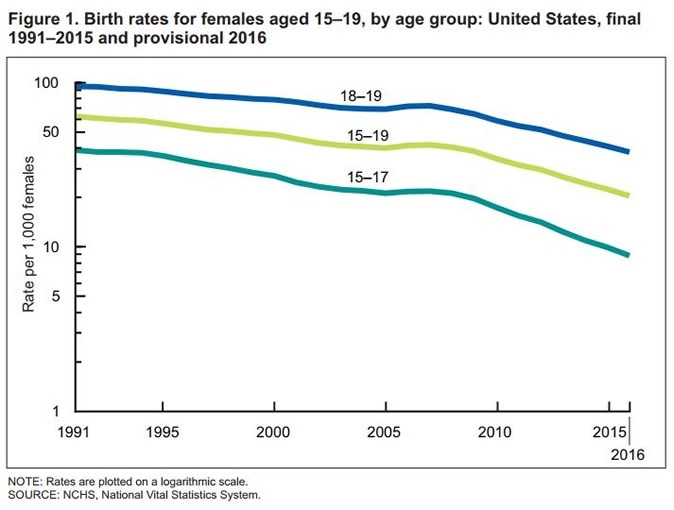The CDC's National Center for Health Statistics has released data for births in 2016 and has come up with some heartening trends. Teenage girls giving birth for example has dropped by 67% in 1997. The reports show that birth rates among teenagers between 15 and 19 years have declined by 51% since 2007. The data comes from analysis of majority (99.96%) of births as of February 16, 2017. The report published last Friday shows that since the year before teenage girls giving birth has dropped by 9%.
According to Brady Hamilton, one of the study’s lead authors, the drastic drop in teenage pregnancy was “astounding”. Experts believe that better access to contraceptives could have been responsible for this trend.

Birth rates for females aged 15–19, by age group: United States, final 1991–2015 and provisional 2016
Results from the analysis of birth have shown that in 2016, there were a total of 3,941,109 births. This was 1% less than 2015 and the fertility rate is 62 per 1000 women. This is a record low says the report.
Birth rates are more for older mothers than for teenage girls. Among women who are aged between 30 and 34, the birth rate increased by 1% from 2015. This is also a record high since 1964 says the report. The ascent of birth rates is 2% among women aged between 35 and 39 a high point since 1962. Among women aged 40 and 44 the birth rates have risen by 4% since 2015 – a high point since 1966. Rates of women older than 45 giving birth are also high but remain unchanged from 2015, say the report. Joyce A. Martin, a co-author of the report and lead statistician says that rates of births outside wedlock have also declined by 3% since 2015.
Michelle J.K. Osterman, a co-author of the report and statistician points out at another bit of the report – an average three of four women get prenatal care in their first trimester. So for 6.2% of the women the visits to the doctor for prenatal care begin in the third trimester or last three months of pregnancy and of they receive no care during pregnancy.
According to Osterman the rates of women getting prenatal care in the first trimester should be 100%. But 2016 was the first time that the agency looked at accessibility to prenatal care and there are no comparisons if it has changed over the last few years.
For non-Hispanic native Hawaiian and other Pacific Islanders women the access to prenatal care in the first trimester was the lowest at 51.9%. For non-Hispanic white women it was around 82.3%. Around 81% Asian women, 72% of Hispanic and 67% of non-Hispanic black women received prenatal care. As a short term target all groups of different ethnicities need to reach the overall rate of over 80% said Martin.
Overall low birth weight of the babies born in 2016 rose to 8.16% in 2016. It was 8.1% in 2015 which was more than the year before. For white women the rate of low birth weight was 6.9% and for Hispanic women it was 7.3%. This was not a desirable outcome and the rates need to be brought down say experts.
The rate of preterm births was also on the rise. There was a 2% rise in preterm births and according to Martin this is significantly high. However there was a decrease in number of Caesarean sections for four years in a row now says the report. In 2016, it stood at 31.9%. Further rates of low-risk Caesarean section came down to to 25.7% in 2016. Overall C-section rates were highest in 2009 at 33%.